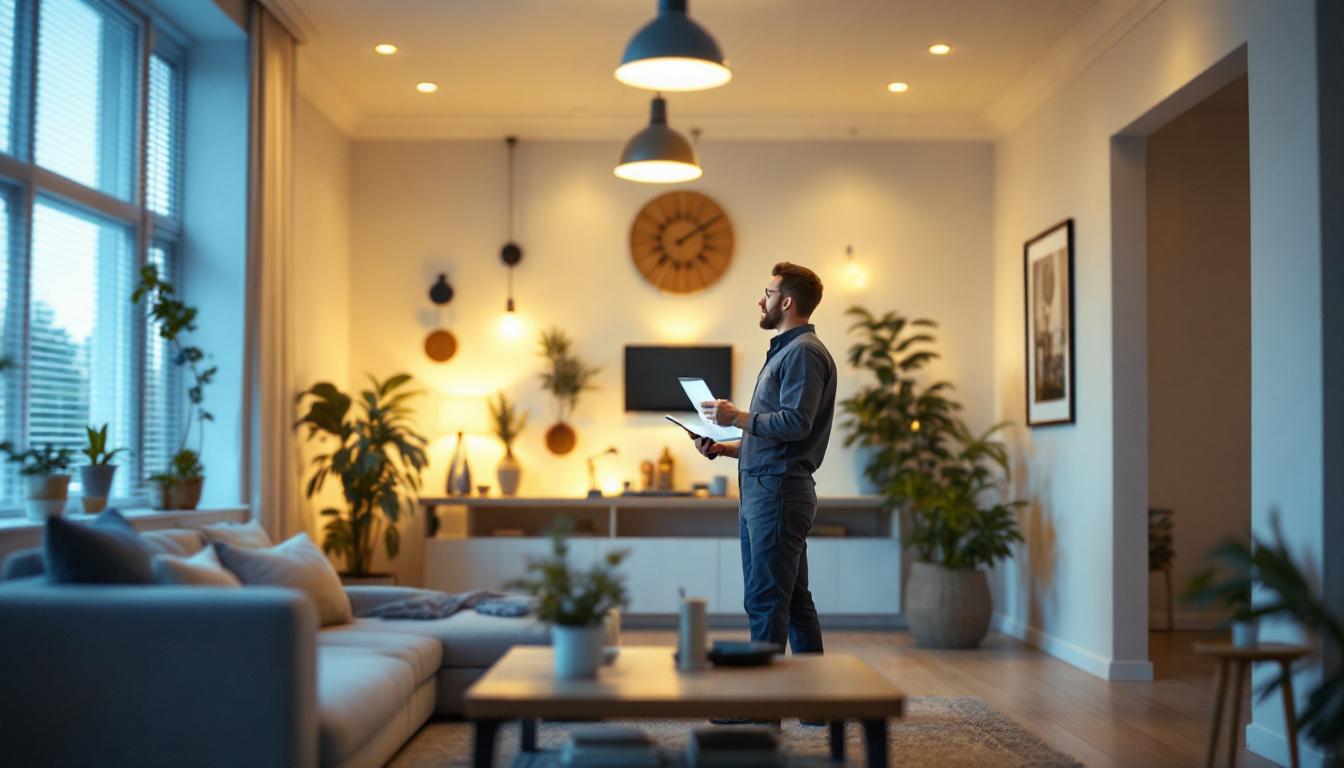
Can lighting, also known as recessed lighting, has become a staple in modern kitchen design due to its sleek appearance and functional benefits. These fixtures are installed flush with the ceiling, providing a clean and unobtrusive source of illumination. For lighting contractors, understanding the nuances of can lighting is essential not only for aesthetic appeal but also for optimizing energy efficiency in kitchen environments.
The kitchen is one of the most frequently used spaces in a home, requiring lighting that balances brightness, color accuracy, and energy consumption. Can lighting offers a versatile solution that can be tailored to various kitchen layouts and design styles. However, the choice of fixtures, bulbs, and installation techniques significantly impacts the overall energy efficiency of the lighting system.
One of the key advantages of can lighting is its ability to create layers of light, enhancing the overall ambiance of the kitchen. By strategically placing these fixtures, homeowners can achieve a combination of task, ambient, and accent lighting. For instance, installing can lights above the kitchen island provides focused illumination for meal prep, while additional fixtures can highlight architectural features or artwork, adding a touch of personality to the space. Furthermore, dimmable options allow for flexibility in lighting intensity, enabling homeowners to adjust the mood according to the time of day or occasion.
Moreover, the advancements in LED technology have revolutionized the way can lighting is utilized in kitchens. LED bulbs not only offer longer lifespans and lower energy consumption compared to traditional incandescent bulbs, but they also come in a variety of color temperatures, allowing for customized lighting experiences. Homeowners can choose warmer tones for a cozy atmosphere during family dinners or cooler tones for a bright, energizing effect during morning routines. With the integration of smart home technology, can lighting can also be controlled remotely, providing convenience and efficiency that aligns with contemporary lifestyles.
The type of bulb used in can lighting is a primary determinant of energy consumption. Traditional incandescent bulbs, once common in recessed fixtures, are highly inefficient compared to modern alternatives. Compact fluorescent lamps (CFLs) offered improvements but have largely been surpassed by light-emitting diode (LED) technology.
LED bulbs consume significantly less energy, often using up to 75% less electricity than incandescent bulbs while providing comparable or better light output. Additionally, LEDs have a longer lifespan, reducing replacement frequency and maintenance costs. For lighting contractors, recommending LED can lights for kitchens is a practical strategy to enhance energy efficiency and client satisfaction. Furthermore, the color temperature of LED bulbs can be tailored to create the desired ambiance in a kitchen, ranging from warm whites that evoke a cozy atmosphere to cooler whites that promote a bright, clean environment ideal for cooking and food preparation.
Energy-efficient lighting is not solely about the bulb; the fixture design also plays a critical role. Can lights must be rated for insulation contact (IC-rated) if they are installed in ceilings with insulation to prevent overheating. Proper heat dissipation extends the life of LED bulbs and maintains fixture performance.
Fixtures with built-in heat sinks or designs that promote airflow can reduce energy waste caused by heat buildup. Lighting contractors should ensure that the selected can lighting fixtures comply with local building codes and energy standards, such as those set by ENERGY STAR or the Illuminating Engineering Society (IES). Additionally, the aesthetic design of the fixtures can enhance the overall kitchen decor, allowing homeowners to seamlessly integrate energy-efficient lighting solutions without compromising style. Choosing fixtures that blend well with cabinetry and countertops can create a cohesive look, while also providing the functional benefits of effective illumination.
Strategic placement of can lights in the kitchen can reduce the number of fixtures needed while maintaining adequate illumination. Over-lighting leads to unnecessary energy consumption, while under-lighting can cause shadows and reduce functionality.
Contractors should work with kitchen designers or homeowners to create lighting plans that balance task, ambient, and accent lighting. For example, placing can lights evenly spaced above work areas like countertops, islands, and sinks ensures focused illumination where it is most needed. Additionally, utilizing natural light sources, such as skylights or large windows, can significantly enhance the overall brightness of the kitchen during daylight hours, reducing the reliance on artificial lighting. This not only contributes to energy efficiency but also creates a more inviting and pleasant cooking environment.
Incorporating dimmers and smart lighting controls enhances energy savings by allowing users to adjust light levels based on activity and time of day. Dimmers can reduce energy use by lowering wattage output without compromising lighting quality.
Smart controls, including motion sensors and programmable timers, further optimize energy consumption by turning lights off when rooms are unoccupied. Lighting contractors should consider these technologies as part of a comprehensive energy-efficient lighting solution for kitchens. Moreover, integrating smart home systems can provide users with the ability to control lighting remotely via smartphones or voice commands, allowing for even greater flexibility and energy management. This level of control not only fosters energy efficiency but also aligns with modern lifestyle preferences, where convenience and sustainability go hand in hand. By adopting these advanced technologies, homeowners can create a dynamic and responsive lighting environment that adapts to their daily routines.
Color temperature, measured in Kelvins (K), affects both the appearance of the kitchen and perceived brightness. Warmer tones (2700K–3000K) create a cozy atmosphere, while cooler tones (3500K–4100K) provide a brighter, more clinical feel.
Choosing the appropriate color temperature can influence energy efficiency indirectly. Cooler temperatures often appear brighter at the same lumen output, potentially allowing for lower wattage bulbs without sacrificing visibility. Contractors should advise clients on selecting color temperatures that complement kitchen design while supporting efficient lighting use.
Additionally, the choice of color temperature can significantly impact the mood and functionality of the kitchen space. For instance, a warmer light can enhance the inviting nature of a kitchen, making it a more pleasant environment for family gatherings or entertaining guests. On the other hand, cooler light can be advantageous during early morning hours or late-night cooking sessions, where clarity and focus are paramount. Understanding the psychological effects of color temperature can help homeowners create a space that not only looks great but also feels right for various activities throughout the day.
CRI measures how accurately a light source reveals colors compared to natural light. A high CRI (above 80) is essential in kitchens to ensure food preparation areas are well-lit and colors appear true, which is particularly important for tasks like cooking and cleaning.
While high CRI LEDs may have a slightly higher upfront cost, their benefits in visual comfort and safety justify the investment. Moreover, these LEDs are generally energy-efficient, making them a smart choice for kitchen can lighting.
Furthermore, the importance of CRI extends beyond aesthetics; it plays a crucial role in food safety. Accurate color rendering helps in identifying the freshness of ingredients, such as the ripeness of fruits or the doneness of meats. In a bustling kitchen environment, where quick decisions are essential, having a lighting system that enhances visibility and color accuracy can lead to better cooking outcomes and reduce the likelihood of food-related mishaps. As such, selecting lighting with a high CRI not only enhances the kitchen’s functionality but also contributes to a safer and more efficient cooking experience.
Lighting contractors must be familiar with local and national energy codes that govern residential lighting installations. Codes often mandate minimum efficiency levels for lighting fixtures and bulbs, including requirements for recessed lighting in insulated ceilings.
Compliance ensures not only legal adherence but also contributes to long-term energy savings for homeowners. Utilizing ENERGY STAR-certified can lighting products is a reliable way to meet or exceed these standards.
Many utility companies and government programs offer incentives and rebates for installing energy-efficient lighting, including LED recessed fixtures. These programs can offset the initial investment costs and encourage the adoption of sustainable lighting solutions.
Contractors should stay informed about available incentives in their service areas and guide clients through the application process. This approach enhances customer satisfaction and promotes environmentally responsible practices.
Several projects have demonstrated the tangible benefits of upgrading kitchen can lighting to energy-efficient systems. For instance, a residential kitchen retrofit replacing incandescent recessed lights with LED fixtures resulted in a 65% reduction in lighting energy use. The homeowner also reported improved lighting quality and reduced maintenance needs.
In commercial kitchen settings, energy-efficient can lighting has contributed to significant operational cost savings. By integrating smart controls and high-efficiency LEDs, facility managers achieved better control over lighting schedules and reduced peak demand charges.
These examples underscore the value of thoughtful can lighting design and installation in achieving energy efficiency goals.
For lighting contractors, the best can lighting solutions for kitchens combine advanced LED technology, appropriate fixture selection, and intelligent design strategies. Prioritizing energy efficiency not only benefits clients through lower utility bills and enhanced lighting quality but also supports broader environmental sustainability efforts.
Staying current with lighting technologies, energy codes, and incentive programs enables contractors to deliver superior service and foster long-term client relationships. By integrating these best practices, contractors can position themselves as leaders in energy-efficient kitchen lighting solutions.
Ready to elevate your kitchen lighting designs while maximizing energy efficiency? At LumenWholesale, we provide lighting contractors with the finest spec-grade lighting products at exceptional wholesale prices. Our commitment to quality and affordability ensures that you can access a vast array of energy-efficient lighting options, including the latest LED can lights, without the burden of inflated costs. Embrace the convenience of free shipping on bulk orders and discover how our premium lighting solutions can transform your projects. Take the first step towards a brighter, more sustainable future and explore our collection for Wholesale Lighting at the Best Value.

Discover how solar lights for garages are revolutionizing the lighting industry with their eco-friendly technology, cost-saving benefits, and innovative designs.

Discover how Tracklight is revolutionizing the lighting industry by providing contractors with cutting-edge tools and insights.

Discover why lighting contractors should make prioritization a key part of their strategy.

Discover how 4-foot fluorescent lights can enhance profitability in lighting installations.